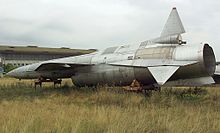Tupolev Tu-121
The Tupolev Tu-121 was the prototype of a Soviet nuclear surface-to-surface cruise missile .
It was developed in the second half of the 1950s in the OKB Tupolew (OKB 156) and was supposed to fly to the destination at a high altitude of more than Mach 2.5. The range would have been around 4000 km. The concept was abandoned during the development phase because advances in air surveillance and air defense no longer appeared to make any sensible use; partly due to advances in the development of nuclear ICBMs .
A total of five prototypes were built with which four test flights were carried out. The first flight of the complete system took place on August 26, 1959. On November 11, 1959, the discontinuation of the program was proposed. Final cessation was ordered in February 1960.
The Tu-123 reconnaissance drone was developed from the Tu-121 .
technology
The Tu-121 had a slim fuselage with delta wings and a conventional tail unit . The KR-15-300 engine was in the stern, the air inlet was on the underside of the fuselage, a little behind the middle and had an adjustable shock wave diffuser . The wings had a sweep of 67 °.
A Zemlya-AI astronomical navigation system in combination with an AP-85 autopilot was supposed to take over control.
The launch would have been from a launch pad using PRD-52 launch support missiles , each producing around 57–80 tons of thrust.
| parameter | value |
|---|---|
| Span (m) | 8.40 |
| Length (m) | 24.77 |
| Height (m) | 4.61 |
| Hull diameter (m) | 1.70 |
| Empty weight (kg) | 11450 |
| maximum takeoff weight (kg) | 35000 |
| Fuel (kg) | 16600 |
| drive | KR-15-300 |
| Thrust (kN) | 67 |
| Cruising speed (km / h) | 2775 |
| Range (km) | 3880 |
| Summit height (m) | 24100 |
| Warhead | 205 , thermonuclear |
Individual evidence
- ↑ a b c d e f g Туполев Ту-121. In: airwar.ru. Retrieved September 1, 2017 (Russian).
- ↑ Tu-121. In: globalsecurity.org. Retrieved September 1, 2017 (English).
Web links
- Tu-121. In: globalsecurity.org. Retrieved September 1, 2017 .
